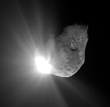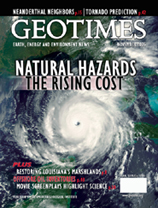
|
|
||||||||||||||
| |
|||||||||||||||
|
 Louisiana's
marshland mess Louisiana's
marshland messComet full of fluff Super-rotation for Earth's core Shift in Chile's seismic history Middens mark Southwest cold snap New Appalachian tale Earthly origin for desert formation Salting a stagnant ocean Neanderthal neighbors Geophenomena
Print Exclusive |
||||||||||||||
|
The Geosciences and Future Foreign Policy U.S. federal agencies are joining up to identify research that could help define decision-making on the international stage. John A. Kelmelis Political Scene A Volcanologist Enters Energy Politics As the United States faces the largest rebuilding project in its recent history, one scientist is gearing up on Capitol Hill. Steve Quane Geologic Column South American Cowboys Travel books can be helpful guides when venturing into new lands. Lisa Rossbacher |
Donald Russell: Paleontologiste franšais Geomedia
Benchmarks
Print Exclusive
|
||||||||||||||
 ON
THE COVER ON
THE COVER Rita was building up to a Category-5 hurricane when this image was captured on Sept. 21, with winds at 220 kilometers per hour (140 miles per hour). When it came ashore on Sept. 24, Rita was a Category-3 hurricane, and it wrought havoc on the Gulf Coast infrastructure, already weakened from Hurricane Katrina just weeks prior. Read more about disaster costs, mitigation and management throughout this issue. Image by the MODIS Rapid Response Team, NASA Goddard Space Flight Center. |
December: Year in Review
|
| SUBSCRIBE | CLASSIFIEDS | ADVERTISE | FOR AUTHORS | CONTACT US | ARCHIVES | SEARCH |
 |
Geotimes Home | AGI Home | Information Services | Geoscience Education | Public Policy | Programs | Publications | Careers |